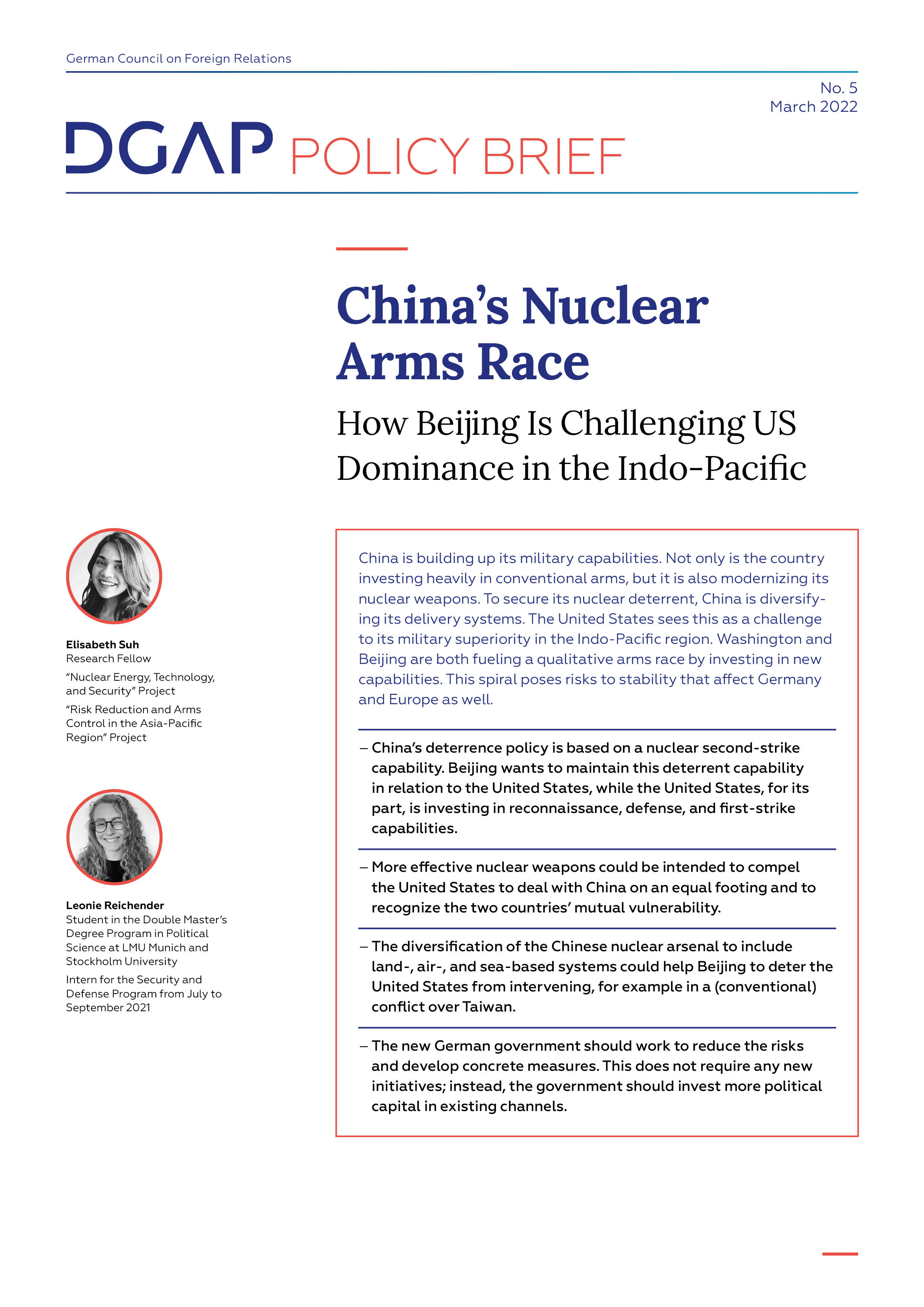Please note that the online version of this DGAP Policy Brief below does not include footnotes. To see them, please read the PDF version here.
| Key Points |
|---|
|
|
|
|
Modernization: Land, Sea, and Air
In terms of its number of nuclear warheads, China ranks in third place worldwide, far behind the United States and Russia. It is estimated to have 350 warheads in total. This figure has risen gradually from just 200 in 2007. In its most recent report, the US Department of Defense speculates that China could have up to 1,000 warheads by 2030. In comparison, the United States currently has more than 3,600 while Russia has more than 4,497 nuclear warheads.
When it comes to the modernization of its arsenal, China is concentrating primarily on improving the delivery systems for its nuclear warheads in both quantitative and qualitative terms. Beijing is clearly seeking to upgrade and diversify its triad of land-, air, and sea-based nuclear weapons. This is intended to increase the “survivability” of China’s nuclear capabilities if the country is attacked. Consequently, its focus is on measures that make intelligence, reconnaissance, and surveillance (ISR) by adversaries more difficult; enable China to strike rapidly; and render the enemy’s defenses ineffective.
As far as land-based systems are concerned, China now has a wide spectrum of missile systems. In summer 2021, reports that Beijing has built at least 250 silos for intercontinental ballistic missiles (ICBMs) caused a stir. Until then, it had been believed that China only had 20 ICBM silos, and this large jump led to fears of a massive build-up of ICBMs and nuclear warheads. However, this increase in the number of silos could also be meant to pave the way for a kind of “shell game” with vacant or non-vacant silos: an inexpensive strategy to make ICBMs more difficult to locate.
China’s intercontinental (range greater than 5,000 kilometers) and intermediate-range (range less than 5,000 kilometers) ballistic missiles are strategically far more relevant; they can be launched rapidly and flexibly using solid propellant and/or mobile launching systems. Capabilities that could challenge or even overwhelm US early warning and defense systems are also particularly important: For example, some of China’s ICBMs can carry multiple independently targetable re-entry vehicles with (nuclear) warheads. Hypersonic systems, such as the DF-ZF hypersonic glide vehicle, are harder to track accurately due to their non-ballistic and flexible flight path. According to reports, in August 2021, China tested a new delivery system that circled the globe before launching a hypersonic glide vehicle.
As far as air-based systems are concerned, China has a range of bombers that can transport and launch cruise missiles. The most strategically relevant is the Xian H6-N bomber, which may be able to carry and launch a nuclear-capable ballistic missile. China is also working on an entirely new system called Xian H-20, which is believed to be intended to be capable of carrying nuclear weapons over very long distances. Although land-based systems can be launched more rapidly and sea-based systems are more difficult to locate, air-based nuclear weapons remain important to China, as they provide for very visible demonstrations of resolve and contribute to diversity.
China’s navy has the largest number of ships and submarines in the world. These include the nuclear-powered submarines of the Jin-class 094, which can carry and launch up to twelve JL-02 ballistic missiles, each armed with a nuclear warhead. At present, China is developing its next generation of submarines (Jin-class 096) and submarine-launched ballistic missiles (JL-03). The key advantage of nuclear-powered submarines over conventional systems is that they are stealthier and can be deployed for much longer periods. Nuclear weapons stationed on such submarines would consequently be more difficult for the United States to locate and track. They could also be deployed relatively quickly for retaliatory strikes.
The Context of China’s Nuclear Modernization
China’s approach to its nuclear forces is determined primarily by the context of the US nuclear arsenal, which is superior in both qualitative and quantitative terms; moreover, the United States is investing heavily in its nuclear modernization. Specifically, Beijing believes that intensified intelligence, reconnaissance, and surveillance (ISR) capabilities by Washington are the main threat to its nuclear second-strike capabilities, the foundation of its nuclear deterrent. Knowing exactly where and how China has stationed which nuclear weapons could enable Washington to carry out precision-targeted first strikes that could effectively disarm China by destroying its (nuclear) second-strike capabilities.
When it comes to ISR capabilities, the United States benefits from its allies in the region. This is true both in terms of information sharing among intelligence services and the information gathered from integrated systems that the United States has sold to allies or stationed on their territory. The fleet of nuclear-powered submarines ordered by Australia and the US missile defense system THAAD stationed in South Korea are also intended to contribute. In particular, the network of missile defense systems is essential for the ISR of the United States. A concrete example is the ship-based Aegis Ballistic Missile Defense System: While it is intended to protect US allies and US military bases in the region from missile attacks, it also serves as an early warning system for the Ground-based Midcourse Defense (GMD) system, whose interceptors, stationed in Alaska and California, are intended to defend the US mainland from incoming ICBMs. In addition, the United States is upgrading its first-strike capabilities, for example in the framework of its longstanding Conventional Prompt Global Strike program.
For decades, the United States has been working to upgrade its ISR, missile defense, and first-strike capabilities; this has been criticized by Beijing (and Moscow) for just as long. Given these long-term trends, it is striking that China’s nuclear modernization is advancing so rapidly right now. Significant political pressure is being used to drive forward these advances. In March 2021, President Xi Jinping demanded greater efforts to accelerate the development of a strategic deterrent of the highest quality. Analysts point to the political escalation of the confrontation between Beijing and Washington: On the one hand, they say, China genuinely fears a first strike or preemptive strike by the United States. On the other hand, they have noted that Chinese opinion pieces are increasingly arguing that a more effective nuclear arsenal would convince Washington to accept China’s status as a (nuclear) power and to tolerate a situation of mutual vulnerability as the basis of mutual deterrence.
Guiding Principles in China’s Nuclear Weapons Policy
China has been considered a nuclear-weapon state since 1964, the year it first carried out a test of nuclear explosives. This status was legalized by the 1970 Treaty on the Non-Proliferation of Nuclear Weapons (NPT). Since then, there have been two principles guiding Beijing’s declaratory policy: “minimal nuclear deterrence” and “no-first-use of nuclear weapons.”
The first fundamental principle of Chinese nuclear weapons policy is not to seek a massive arsenal of nuclear weapons. China has always sought to distinguish itself from both the United States and the Soviet Union or Russia in this respect. The Chinese foreign ministry reiterated in 2022 that China does not intend to possess more than the minimum number of nuclear weapons necessary to deter potential attacks and guarantee its defense. How this “minimum” and any adjustments are defined, however, is unclear.
The second principle in China’s nuclear weapons policy is its stated intention to refrain from using nuclear weapons first in any conflict. According to this political pledge, China would not “introduce” nuclear weapons to a conflict. However, this declaration does not rule out the possibility that China could also use its nuclear weapons in response to an imminent nuclear strike (“launch on warning”).
The interpretation and operational implementation of these two political principles remains ambiguous. However, Beijing is unwavering in its determination to ensure its capabilities for nuclear retaliation, the foundation of its nuclear deterrence posture. In the scenario of a war with the United States, this means that China wants, under all circumstances, to be able to respond to a nuclear first strike by Washington by carrying out a direct nuclear second strike against the US mainland. To guarantee this second-strike capability, the Chinese military must ensure that the country’s own nuclear warheads and delivery systems survive the adversary’s nuclear first strike, for example because they are stationed in robust or undetectable locations. There is also a need for rapid and reliable ISR and early warning capabilities, highly responsive communication and command structures, and the ability to deploy China’s own systems immediately. Accordingly, the primary aim of the modernization of China’s nuclear triad is undoubtedly to secure its second-strike capabilities despite US nuclear modernization, and thus to maintain the credibility of the Chinese deterrent.
Yet in this context, too, analysts point to the political and strategic escalation of the confrontation with the United States as drivers for China’s rapid strides in nuclear modernization. Diversifying its nuclear arsenal gives Beijing greater flexibility and expands its options for action in the region: In particular, the increase in the number of missile systems with short, medium, or intermediate ranges (less than 5,000 kilometers) could be used by China to reciprocate limited nuclear strikes by the United States and respond proportionately. From the Chinese perspective, this would allow China to engage in escalation management: A direct retaliatory strike against the US mainland would then be “only” the next stage of escalation. In this way, Beijing would call into question Washington’s monopoly on escalation management and would be able to determine the escalation spiral itself. This option could enable China to gain the upper hand in the event of a conventional or limited nuclear conflict in the Indo-Pacific.
A Destabilizing Arms Race
Only limited inferences about intentions can be drawn from technical developments and official rhetoric. Inevitably, room for interpretation remains. The way a country presents itself also serves to reinforce its threat posture and deter potential adversaries at an early stage. That said, China’s massive military build-up and nuclear modernization are taking place at a time when geopolitical confrontation and mutual distrust between Beijing and Washington are defining the framework for interpretation and reaction. The fact that Xi Jinping has repeatedly affirmed China’s determination to reunify with Taiwan is worrying. Likewise, the show of force by the Chinese air force when it entered Taiwan’s air defense zone to carry out a significant number of overflights has fueled concern that a conflict could take place in the region. Should China be able to call into question America’s dominance in the Indo-Pacific, it may see this as a sign of US weakness. Against the background of its diversified nuclear arsenal and its deterrent effect, Beijing might then be tempted to assert by force its claims to territory and power in the region.
The overall direction of developments leaves little room for interpretation: An arms race is currently accelerating between China and the United States, in which the focus is less on quantity than quality – not the number of nuclear weapons but the strategic characteristics of nuclear forces. Non-nuclear capabilities are also increasingly playing a role in this context. Firstly, many delivery systems are dual-capable, meaning they can carry nuclear or conventional warheads, and, secondly, non-nuclear capabilities can also inflict strategically relevant damage. Moreover, new technologies in the fields of ISR, early detection, command, and communication are creating additional uncertainty for (second) strike capabilities. A qualitative arms race, in which both countries develop new capabilities to remain ahead, undermine the other’s capabilities, and retain the upper hand in the event of a (nuclear) conflict, is already having a hugely destabilizing effect.
This escalation in the Indo-Pacific is also strategically relevant for Germany and Europe. A conflict in the region would affect them directly – in political, economic, and potentially also military terms. European countries will have to determine their stance on China within the framework of NATO’s ongoing negotiations around its new strategic concept that will be announced in June 2022. The EU needs to adjust its positioning on an ongoing basis and translate both its recent Indo-Pacific Strategy and its definition of China as a partner, competitor, and systemic rival into action. Germany, as a leading export nation and supporter of the international rule of law, has a major interest in regional and strategic stability.
The qualitative arms race between China and the United States is on the agenda of the new German government. The policy guidelines on the Indo-Pacific region adopted in 2020 already contained a commitment to “arms control and export control policy engagement.” In their coalition agreement, the governing parties have now promised a “disarmament-policy offensive.” Members of the coalition government are also promising a concrete China strategy and, in general, a concise national security strategy. It is true that Germany is not a major player in the Indo-Pacific, especially in military terms; nonetheless, it is important to make use of the collective interest in strategic stability. This does not require any new intergovernmental initiatives. Instead, the German government needs to use existing multilateral formats, such as the Stockholm Initiative or the Non-Proliferation and Disarmament Initiative (NPDI), to develop concrete measures to promote stability and reduce risks. It has started to do so, but this requires active engagement of the nuclear-weapon states recognized by the NPT, the so-called P5, to take action toward risk reduction. In January 2022, the P5 set expectations for actions with their joint statement on “Preventing Nuclear War and Avoiding Arms Races.”
Initiatives by the previous German government, such as the Missile Dialogue Initiative or the Rethinking Arms Control conference, encouraged exchange between representatives and researchers. They should, and likely will, be continued. However, it is important to step up the involvement of stakeholders from various institutions in the region. Other formats could be used to foster, for example, the dialogue between researchers from the countries of the Organization for Security and Co-operation in Europe (OSCE) and of the Association of Southeast Asian Nations Regional Forum (ARF). This kind of exchange of experience about regional confidence-building measures would at least be a new approach to promoting stability.




